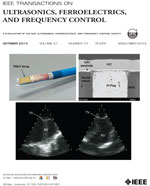| IEEE.org | IEEE Xplore Digital Library | IEEE Standards | IEEE Spectrum | More Sites |
|
|
|
To ensure you receive our e-mail, please add e-mail@ieee.org to your address book now.
|
|
In this issue
Transactions on UFFC
The October Issue of Transactions on UFFC is in the mail and is retrievable now from IEEE Xplore, the IEEE online digital library.
All UFFC members can access the online edition using their IEEE Account. 
Most downloaded articles:
For Newsletter comments, suggestions, critique, etc. contact Mike Garvey rmgarvey@ieee.org
|
Draft Standard on Piezoelectric Crystals by Zuo-Guang Ye, Working Group Chair Over the past few decades, relaxor-based piezoelectric single crystals (piezocrystals), such as lead magnesium niobate-lead titante (PMN-PT) and lead zinc niobate-lead titanate (PZN-PT), have been widely investigated owing to their large piezoelectric coefficients and electromechanical coupling factors, and electric-field induced strains of over one percent. The technical significance of these properties to devices is enormous; it includes a doubling of bandwidth, decreased package size, and increased resolution in electromechanical transducers and actuators. As the materials have matured, the properties have been refined, and there are numerous compositions commercially available. The exploitation of these electroactive single crystals is currently underway in the medical ultrasonics industry and in naval sonar. To facilitate the transition of piezocrystals from the research arena into commercial devices, an industry-accepted material standard is required. A material standard is a published document that establishes specifications and procedures designed to ensure the reliability of a material. A material standard can address a range of issues, including, but not limited to, setting users’ (device designers’) expectations for material properties, developing a common vocabulary, and providing the basis for a common understanding that supports discussions between producers (crystal growers) and users. By providing this foundational information that can be universally understood and relied upon, a material standard plays a critical role in supporting product development. This should decrease time-to-market of a new material and make it easier to understand and compare materials and devices from different vendors. A standard also helps provide credibility for the development of new products and new markets. This standard had its genesis in 2000 when a group of crystal growers and device manufacturers met for the first time at the suggestion of Yohachi (John) Yamashita and recommended the development of a material standard for the PMN-PT and PZN-PT piezocrystals to support the development and use of these new materials. Since 2000, device designers, crystal growers, and materials researchers from industry, academia, government, and non-profits organizations from eight countries have met to discuss the scope and content of the standard. The early discussions were chaired by Seung-Eek (Eagle) Park. Following Eagle Park, Sorah Rhee chaired the discussions for several years. Since 2007 Zuo-Guang Ye has served as Vhair. Throughout this time, Lynn Ewart has served as Vice-Vhair. As the discussion evolved, this group turned to the Ultrasonics, Ferroelectrics and Frequency Control Society (UFFC) of The Institute of Electrical and Electronic Engineers (IEEE) and the IEEE Standards Association (SA) to support the piezocrystal material standard development. Throughout its proceedings, the group adhered to the IEEE-SA’s five principles underlying the standard development and balloting processes: a) due process, which requires that procedures are known by all involved and are followed; b) openness, which requires that all interested parties can participate; c) consensus, which requires majority rule; d) balance, which requires that all interested parties are involved in the process and that there is not an overwhelming influence by any one contingent; and e) right of appeal, which requires that anyone can appeal at any time a decision made during the development and approval of a standard. Over time, the scope of the standard was established and an IEEE-SA Project Authorization Request (PAR) was written. A PAR is a document that details the reason for a standard project and its scope. The UFFC is the PAR sponsor. The UFFC also provides technical oversight for the standard and determines the scope and nature of the technical content. The UFFC submitted the PAR to the IEEE-SA New Standards Committee (NesCom) in the spring of 2012. After NesCom comments were addressed, the NesCom recommended the IEEE-SA Standards Board approve the PAR. The PAR allows the establishment of a Working Group (WG) to write a standard within the scope of the PAR. The PAR was approved on Aug. 25, 2012 as P1859 Relaxor-Based Single Crystals and the Relaxor-Based Single Crystals WG was officially formed. P1859 PAR is approved until 31 December 2016 at which time the WG must have completed the standard or applied for an extension. A website has been established at http://standards.ieee.org/develop/project/1859.html as a communication vehicle about P1859 and the WG. The PAR states that the standard will cover the physical and electromechanical requirements for relaxor-based piezoelectric single crystals of PMN-PT and PZN-PT composition with <001> poling that are intended for fabrication into single plates, multilayer plate devices, and composites with other passive materials for use in medical, industrial, and military transducers, actuators, and sensors. The WG has written a draft standard within this stated scope. The heart of the standard is Section 6 and its tables containing values for material properties deemed important for device design. The content of the standard includes a) definitions of terminology; b) comments on crystallographic and poling orientation, surface conditions and electrodes, poling, and phase purity; and c) discussion of test methods not covered by other existing standards. There are also three appendices with information on crystal uniformity within a wafer; purchase information, requirements; and packaging. The draft standard evolves over time through ongoing discussions that not only produce a standard but also evolve the understanding of the communities served by the standard. This has been particularly well exemplified in two areas with this draft standard. First, the discussions have led to the development of a common vocabulary between the materials community and the device community. Initially, the standard defined and presented data for two temperatures: the rhombohedral to tetragonal transition temperature, TRT, and the depoling temperature, TDP. TRT was included at the request of the crystal growers and materials researchers. TRT was defined as the temperature of the first peak or discontinuous anomaly in free relative dielectric permittivity versus temperature curve, measured during heating of unpoled crystals at 1 kHz under no electrical and mechanical bias. The variation in free relative dielectric permittivity with sample temperatures is measured according to ASTM Standard D2149-97. Data for TDP was included at the request of the device designers. TDP was defined as the temperature of the first peak, or discontinuous anomaly in free relative dielectric permittivity versus temperature curve, measured during heating of a poled crystal at 1 kHz under no electrical or mechanical bias. The variation in free relative dielectric permittivity with sample temperatures is measured according to ASTM Standard D2149-97. After numerous discussions, the unanimous decision was made to remove TDP as it is not a material property and its measured values can vary greatly depending upon many measurement factors, and most notably, through the course of the discussions the device designers became comfortable with the use of TRT instead of TDP. Secondly, the discussions during the development of this draft standard have lead to a common understanding of the differences in how the materials community and the device design community think about material orientation with respect to poling. For the materials community, the crystallographic orientation is most important. For the device community, the orientation between the applied electric field direction and the direction of strain is most important. These differences are further reflected in the nomenclature of the two communities. A full explanation is provided in the draft standard in Section 5 on orientation. This draft standard is the product of fruitful discussions between crystal growers, materials researchers, and device designers. Now, with a draft standard in hand, there are two purposes to publishing it in advance of going to ballot. First, the WG would like to solicit suggestions and comments on the draft standard to improve and strengthen it. Secondly, the WG would like to solicit the names of those that may be interested in balloting on the draft standard. A broad balloting group meets the IEEE-SA goals of having broad international representation of all interested parties balloting on a draft standard. In support of these purposes, please contact: Zuo-Guang Ye
|
|
Contact & Support |
Privacy & Opting Out of Cookies |
Terms & Conditions |
Nondiscrimination Policy
A non-profit organization, IEEE is the world's largest professional association for the advancement of technology. © Copyright 2014 IEEE - All rights reserved. Use of this newsletter signifies your agreement to the terms and conditions.
For more information or questions regarding your IEEE membership or IEEE Web Account, please direct your inquiries to the IEEE Contact Center. |

 Request for Comments and Balloters “Draft IEEE Standard for Relaxor-Based Piezoelectric Single Crystal Materials for Transducer and Actuator Applications".
Request for Comments and Balloters “Draft IEEE Standard for Relaxor-Based Piezoelectric Single Crystal Materials for Transducer and Actuator Applications".